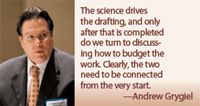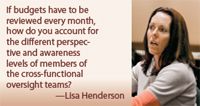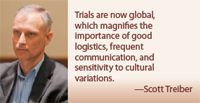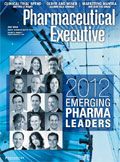Today's Mission Critical: Making Sense of Spending on Clinical Trials
Pharmaceutical Executive
Mastery of the clinical trial process has become essential to positioning new therapies for leadership in an increasingly crowded-and lengthy-race to registration.
Mastery of the clinical trial process has become essential to positioning new therapies for leadership in an increasingly crowded—and lengthy—race to registration. Internal capabilities are a key differentiator against the competition, particularly as the cost, scope and complexity of the trials mandated by regulators continues to expand. The Tufts Center for the Study of Drug Development (TCSDD) looks periodically at best practices in the management of clinical trials; in cooperation with software vendor ClearTrial LLC, TCSDD recently completed a research study looking specifically at how Big Pharma plans and executes its budgets for individual trials. On May 15, Pharm Exec, ClearTrial, and the Center convened a group of leading industry players to review the findings and explore the implications for improving what has become a strategic necessity—to get trials done quickly, across functions and geographies, with the right information required by regulators, and at a cost that accommodates the finely parsed P&L goals set by top management.

Photos: John Halpern
William Looney, Pharm Exec: There is an implicit perception that the development cycle in Big Pharma suffers from a lack of attention to operational excellence—the science may be golden, but the process is perfunctory. Is this accurate based on what you have observed from the review of how companies execute around trial budgets, especially as trials now account for a larger proportion of the cost to bring a compound from discovery to market?
Ken Getz, TCSDD: External forces bearing down on the industry—the patent cliff is one—require more attention to the management of resources. With so much uncertainty, the focus is on enhancing efficiencies around internal activities you can control. One red flag is the cost of development failure, which is also a surrogate for risk and predicting the successful performance of R&D investments. The numbers are sobering: roughly 70 cents of every dollar spent on R&D ends up as failures, many at the most costly late stages of the trial process. This figure is unacceptable now that more products face generic competition, pipelines are weak, and new drugs confront a slower take up in the market. An interesting statistic is that drugs coming on the market in the next two years are expected to generate only 40 percent of the revenues foregone due to loss of patent exclusivity. In addition, little progress has been made on speed to market; development cycle time on average is what it was in the early 1990s.

Complexity is a key factor that creates unpredictability in the trial protocol and leads to higher costs. Our research with companies found that timelines were being slowed by a significant increase in change orders to the protocol, especially at late stages in the trial. On average, we calculated five change orders in Phase III. In contrast, site performance—defined as how well each site selected for a trial does in enrolling the right cohort of patients—is better than we expected; only 11 percent of sites in our survey failed to enroll any patients. The real problem is the time it takes to achieve the enrollment target. Most companies report it is now about double what was originally planned. When resources were flush, companies would simply engage more sites and absorb the costs. It is much harder to justify that ad hoc strategy as margins for existing medicines decline.
At the same time that a harsh operating environment demands that companies do a better job at forecasting, budgeting, and planning, there is a trend toward outsourcing many critical functions. The result creates a disconnect: while management presses for more certainty and accuracy in meeting development goals, the resources needed to execute these goals are more dispersed and less subject to internal control. In this situation, how well you manage the trial budget makes the difference between success and failure.
The conclusions from our review of the trial budgeting process are as follows. First, there is no common home for the budgeting function in the 31 companies we covered. Surprisingly, only a quarter of the companies located this task in finance or procurement. Most—more than a third—housed the function in clinical operations, leading to a high degree of decentralization; each therapy unit or even each trial might have its own in-house staff handling this task. In general, what you have is a large degree of fragmentation, leading to silo approaches.
This is reflected in our second finding, which is a significant variation in budgeting tools and technologies. These ranged from reliance on sheer intuition and experience drawing from previous trials, and captured on simple spreadsheets, to the latest customized software. What was surprising is the poor integration of these tools across functions, within the same company, where the only practical way to share and interpret is through face-to-face meetings—which of course takes time. Lack of standardization and compatibility across functions is a big drain on productivity.
Andrew Grygiel, ClearTrial: One factor that may contribute to the confusion is the failure to incorporate budgetary issues into the development of the trial protocol. What tends to happen is the science drives the drafting, and only after that is completed do we turn to discussing how to budget the work. Clearly, the two need to be connected from the very start.

Getz: Our research showed that while most companies acknowledge budgeting should be an integrated, forward-looking activity, few—less than one out of five—have any capability to track budgeting at each stage of the trial. We are talking to companies about this in more detail and a preliminary conclusion is that the emphasis is figuring how to upgrade and improve the process overall—right now there is no baseline to monitor budget performance. This also shows up in our findings on how companies determine a budget variance threshold for each trial, and whether this figure—usually it's 10 percent—is applicable in terms of adherence. We found the variance is subject to constant adjustment, which leads us to conclude, again, that if the system itself lacks sophistication, then the metrics around it are likely to be less than meaningful. Yet the need for accurate budget numbers is more vital than ever.
Looney: What does the study say about why it is so hard to accurately account for expenditures, beyond these basic organizational factors?
Getz: Two things come up here. One is the failure to build the right assumptions into the protocol design; requirements change and the protocol has to be redrawn or adjusted. The other relates to outsourcing activities and decision-making powers to CROs, who tend to get blamed for missed signals around the initial objectives, over-confidence that they can deliver what the trial sponsor wants, or deliberate underbidding to obtain the contract. Regardless of who is to blame, modifications to protocol are proliferating, raising the expense of trials, and ratcheting up the pressure from management to get more control over what is being spent. The growing regulatory requirement for Phase IV post-marketing studies poses a huge burden on companies because of their length, detailed safety profiles, and population size. Such studies have to be done right, from the start.
Looney: Looking beyond the Tufts study, what do those of you representing companies confront in managing your own trial protocols? Are the study conclusions consistent with reality as you see it day-to-day?
Amy Guzman, Biogen Idec: We are grappling with many of the issues highlighted in the research, particularly with managing changes to study budgets. My group is part of clinical operations while much of the budgeting for the company is handled through finance. Their perspective is relatively short term, whereas we often have to plan way forward; some clinical development plans have costs forecasted out to 2025. Our planning process is working toward a more centralized approach, with a better baseline built around hard, quantifiable assumptions. In addition, we are now part of the same unit responsible for the design and execution of study protocols, and the lead for each protocol also has accountability for the budget. This means in practice we will no longer encounter situations where our people worked with the trial physicians and agreed to actions without any idea of what the costs would be. In the latest planning cycle, we made significant strides by being able to present to senior management total program costs and a total budget for each study, from start-up to close out.
The changes are very important due to the fact that Biogen Idec currently has multiple Phase III programs in progress, with only two major drugs presently on the market. The financial pressures on completing this trial work on time, and at an appropriate cost in line with regulatory requirements, are considerable. Our new CEO has instituted a change in which each therapeutic program lead reports directly to him and has P&L responsibility for that program. If there is a need to adjust the program budget against the operating plan, then an offset has to be found or it won't go through. Significantly, however, the trial budget itself remains a line responsibility. So to some degree we are still devolving accountability for trial costs.
Scott Treiber, Hospira: Hospira is a spin-off from Abbott Labs and our focus is on hospital products, including generic injectables. About three quarters of our revenues are in the United States, but we are seeking opportunities in other countries with particular emphasis on Asia and the emerging markets. Biosimilar products are part of our growth plan. Among other tasks, my role is to coordinate budgeting for two major Phase III programs focused on obtaining approval for a biologic equivalent to Amgen's Epogen. This is a high-stakes move for us. Overall we are earmarking upwards of $100 million for this project; $55 million this year alone, out of a total R&D budget of $300 million. Hospira is mainly a generic business and margins are very thin. Churning that revenue back into R&D represents a sacrifice today in the hopes of a buoyant future.

My main concern right now is spending this money productively and keeping within the 10 percent budget variance that we adopted at the start of the trial process. With $100 million at stake it's a big deal when you exceed that variance. It may be counterintuitive but I also work to see that we don't underspend too. Spending too little means that you are not working toward the goal of getting a compound to the market as quickly as possible. As soon as a drug moves off patent, we want to be there waiting, ready to go. We have a fixed date; a real deadline when the market opens up. So I follow that spend and make sure we are spending all that we said we would in executing against plan.
Like Biogen, we have made good progress in coordinating the tracking of our trial spend with a common software system. The challenge is working with our finance people to help them understand that a lot of trial costs involve seemingly unrelated activities that are not invoiced for long periods of time. Trials are now global, which magnifies the importance of good logistics, frequent communication, and sensitivity to cultural variations. If you get these right, you will save money. Hospira is taking a close look at whether our trials need to be global. Can we run a well-controlled trial here in the United States and another in one other region and just combine the data? The proposition that a definitive trial is a global trial is worth challenging, particularly because the complexity can outweigh the benefits of a broader enrollment pool and lower recruitment costs.
Clement Popovici, Takeda: We are now managing against a five percent target for the overall budget variance. Due to the current nature of the industry, the scrutiny on the financial side has increased. In order to spend the available budgets, teams need to become more accountable on what we are going to spend on our trials. In order to improve efficient use of the R&D budgets, the teams are doing a monthly evaluation of actual spend and current plans against the previously submitted plans. This allows for a quarterly review with senior management to address where opportunities may have arisen or if additional funding is necessary. The teams are encouraged to pressure test their assumptions in order to minimize variance against the plans. This also allows for greater transparency on the assumptions and plans across the organization—the "no surprises" philosophy. It is building awareness and managing expectations. So if we know we have a change to the protocol on the way, we can anticipate early any impacts. For example, if more site monitoring visits are required we build that into the budget updates. Instead of a significant 20 percent variance that pops out at the end of the study you have a series of smaller ones that are more easily managed in a fiscal year perspective and don't end up surprising everyone, including senior management.
Lisa Henderson, Applied Clinical Trials: If budgets have to be reviewed every month, how do you account for the different perspective and awareness levels of members of the cross-functional oversight teams? Do the monthly reviews lead to significant changes in activities or a frequent reallocation of resources?

Guzman: Our reviews are mainly done to help finance get a clear picture of where we are heading and to identify any possible red flags that might require a course correction.
Popovici: For us, the process is to build awareness and agreement in from the leadership before decisions are made. This is critical when you have a cross-functional group that may carry individual assumptions based on the way each group operates.
Treiber: We address this by making our accounting activity-based so that all can understand where and how the spending takes place. So if we have to do 40 new monitoring site visits, we tell them what the cost is going to be for this activity and what bill they can expect for that next month.
Grygiel: Please explain how trial performance around budget variances affects how your work is evaluated. Is it linked directly to your compensation? In other words, how does your company create an incentive to ensure these variance targets are met?
Guzman: Adherence to the annual budget is included in the overall department budgets. Clinical operations teams and individuals are held to the goal and are expected to meet it. Performance is evaluated against that and to how much control your job gives you over meeting the target.
Treiber: We have to meet a certain profit and revenue target and the trial spending feeds into that. Failure to meet the thresholds ratchets all the way down through the organization.
Popovici: Our target is linked to the overall R&D budget performance. Management acknowledges that you cannot run each study or program at the same threshold. It's the overall target that counts. The efforts we make around budget transparency and balancing between the different programs facilitates reaching that R&D goal.
Looney: I want to ask Andy Grygiel how ClearTrial sees the budgeting environment for companies today. Are the views expressed so far in accordance with what you see from clients?
Grygiel: There is significant pressure on staying within those budget variances. We see considerable interest in our software tools that help companies prepare accurate—and defensible—trial budgets. Another priority is building platforms that integrate functions and allow for the optimal exchange of information—information that is accessible and understood. Success in budgeting is mostly about having a common vocabulary. Technology is advancing to make that happen, seamlessly.
It is surprising, however, that few companies are seeking to apply this technology to understand the many marginal differences that occur through the full budget lifecycle, in terms of what was contracted for and what was actually delivered or spent.This can add up and the question should arise, if we performed these tweaks, what kind of additional savings or efficiencies could we expect? It's a question that's just not being asked.
Looney: Do trial budgets figure in thinking at the top of the "c-suite." Wouldn't the typical CEO say getting to registration is what counts and if you have to spend more to get there, then the end justifies the means?
Guzman: Trial costs have advanced to the point that they can affect the revenues you expect to obtain once a product is commercialized. The NPV calculation matters and leaders are appropriately focused on that.
Getz: The new reality is that trials are so long and expensive, just as more pressure is put on companies to deliver results in the short term. The CEO has to ensure a balance between the two. Like everything else, the clinical trial has to evidence value in supporting the path to commercialization, efficiently, and at lowest possible cost. In the days when there were blockbusters able to command multiple billions of dollars in sales, companies could overlook a 40 percent variance in trial budgeting. Today, margins are often razor thin so you don't wish to be saddled with a big overhang from the trial, especially as many of these trials are now Phase IV—post marketing.
Looney: With the Tufts study now out, are there other areas where the Center can make a contribution around budget awareness?
Treiber: Scrutiny is needed around the complexity of the trial protocol. Industry is collecting massive amounts of data at considerable cost, and often little of it is actually used.
Getz: The Center is about to publish a study that estimates the economic cost of unused protocol trial data. There is so much clutter in protocol designs today. Companies collect data that is not tied to the primary or secondary endpoint because it is assumed that regulators will want to have it. Or that adding a single procedure to the protocol might be useful sometime in the future. The point is the cost of doing all of these tertiary and exploratory procedures really adds up.

Looney: What are the key organization and functional skills that are required to address many of the environmental issues we have discussed and keep pace with rapid changes in the trial process? Do you have the proper resources to excel?
Guzman: Coordination is a critical element in the trial manager's toolkit. Clinical operations, therapeutic programs, and finance all have to work together to build more efficiency into what has become a very complex process, with many moving parts. Getting the right information to the right people, at the right time is vital, and that information must include the financial implications of every decision that we make on a trial. What we see often in the long range planning around new compounds is a heavy focus on the science. And that is appropriate because if there is no scientific merit, why waste time and resources? Increasingly, however, the costs of development are such that true scientific merit may be unclear for an early stage asset, when you are putting a price tag on getting it to Phase III.
Treiber: I would add oversight capabilities to the armamentarium. We have a lot of people who are good at running trials but not so good at overseeing progress and certifying results. The latter cannot really be taught; it comes with experience. And, generally, the industry does not have enough of these people.
Looney: How does the regulatory agency viewpoint on risk affect your mandate and the workload in financing good clinical trials?
Getz: The FDA and also the EMA have lately been very busy, particularly in defining the relationship between risk and benefit. When the agencies act, it usually leads to higher costs to industry. This is because an action by the FDA with the goal of streamlining an activity actually tends to motivate companies to allocate more resources. The one area where this may not hold true is risk-based monitoring. The FDA and the EMA hope to see companies ease study monitor burden through a risk-based approach versus 100 percent source data verification. Given that CROs are the primary provider of monitoring services, with a growing percentage of relationships under preferred pricing arrangements, I expect to see CROs reduce their study monitor headcount in anticipation of risk-based approaches. This practice will boost CRO profitability, but it may ultimately reduce overall monitoring capacity.
Looney: Data is often seen as the solution to efficiency deficits and escalating costs. Is more and better data a prerequisite for accurate planning—if so, where are the gaps? Has technology kept pace with the move toward fully integrated operations?
Getz: Industry collects enormous amounts of data, but much of it is useless. The truth is you cannot manage what you are not measuring correctly. What industry needs is to be much better at articulating a standard set of quality-based metrics—metrics that provide insights. The Metrics Champion Consortium is one such effort underway to do that.
Popovici: There is a challenge in the understanding across industry about financial metrics that we can use to track performance in the trials space. We are very good at data built around development cycle times and enrollments and site monitoring. In those cases there is a baseline understanding on definitions and terminology on which to measure. On the budgeting side, there is less consensus on how comparable metrics would be across companies or what you are measuring against.
Guzman: We are working toward defining a standard for baseline that can be used to evaluate variances in a trial budget.
Treiber: I wonder whether any such metric is possible. These trials span different therapeutic areas. They are global, with multiple sites; the metric in Norway just can't be the same as in the United States. Our efforts are focused on developing only a few and to apply them only to the present tense.
Grygiel: Information is abundant and the tools to make sense of it are there. Our challenge as a vendor is finding the right people in the organization who know what they want and are committed to overcoming the preferences that colleagues may have just because it's comfortable for them. What we look for is good organizational alignment as the starting point for creating systems that provide better metrics.
Popovici: For Takeda, the issue is not only the standardization of metrics. It's also finding processes that allow for flexibility and integration in how all the data can be used and analyzed. We want to be able to tie our systems to something that can be measured consistently and help create future process improvements. There is a need for tools that talk to each other across the functions; both operational and financial.

Grygiel: We must acknowledge that we are at the aspirational stage in the application of data to build consistency in trial budgeting. There is potential in all directions. ClearTrial launched in 2007 with a customer base in clinical operations. Then we found that outsourcing was interested in working with us, followed by finance and now resource management. It raises a useful but unsettling question: who is our customer?
Looney: To conclude, what changes or improvements do you see in the trial budgeting process moving forward, over the next three years?
Grygiel: There will be a marked shift toward more outsourcing. This means that companies have to collaborate more with the organizations they outsource to. Better joint planning, beyond simply sharing spreadsheets. Another change is the need for more understanding of the difference between what was planned in the budget and what actually happened. This information has to be evaluated in real time and sent back into the planning process so that it can serve as a source of meaningful advice. It's the starting point for acceptable metrics. Third is being able to incorporate learnings from throughout the industry and using these to shape your own budget planning.
Getz: Patients are going to be more involved in the crucial area of protocol design. They could play a huge role in helping us understand what makes a protocol feasible and executable. Building in that patient perspective can help improve the accuracy of budgets too as patients help ground a study in terms of what can reasonably be performed during the life of the protocol.
Treiber: Collaboration is the strand that runs through everything we discussed today.
It is a theme much larger than budgeting more efficiently, but the end result is the same. Consider all the efforts underway to build a collaborative platform around biomarkers, which allows for better targeting of patients who could benefit from a therapy. It will help reduce our patient trial numbers as well, with an even bigger impact on our costs. Patient groups like the Myelin Repair Foundation are funding researchers that collaborate in MS research. The industry just has to reach out—and be prepared to accept the "out-of-the-box" idea that on close examination carries great merit. Another area where more focus is required is the investigator grant—two thirds of the average trial bill comes from indirect sources; a lot of this is investigators charging us disparate amounts for their work.
Popovici: Collaboration is also going to be more global. Our trial work will need to be sensitive to the requirements of not only the FDA and the EMA but of the many emerging markets as well. Trying to accommodate their different regulatory demands and expectations will induce some conflict. It will test our functional capabilities and ability to be flexible. Hopefully, we can improve on becoming more aware of the diverse requirements and build a more efficient global development program rather than regional ones.

Addressing Disparities in Psoriasis Trials: Takeda's Strategies for Inclusivity in Clinical Research
April 14th 2025LaShell Robinson, Head of Global Feasibility and Trial Equity at Takeda, speaks about the company's strategies to engage patients in underrepresented populations in its phase III psoriasis trials.
The Misinformation Maze: Navigating Public Health in the Digital Age
March 11th 2025Jennifer Butler, chief commercial officer of Pleio, discusses misinformation's threat to public health, where patients are turning for trustworthy health information, the industry's pivot to peer-to-patient strategies to educate patients, and more.
Expanding Immune Response Testing to Support Vaccine Development
April 22nd 2025Nigel McCracken, chief operating officer, Virax Biolabs, discusses the expansion of its ViraxImmune platform into areas such as transplant monitoring, vaccine efficacy, latent virus reactivation, and CAR T cell therapy.